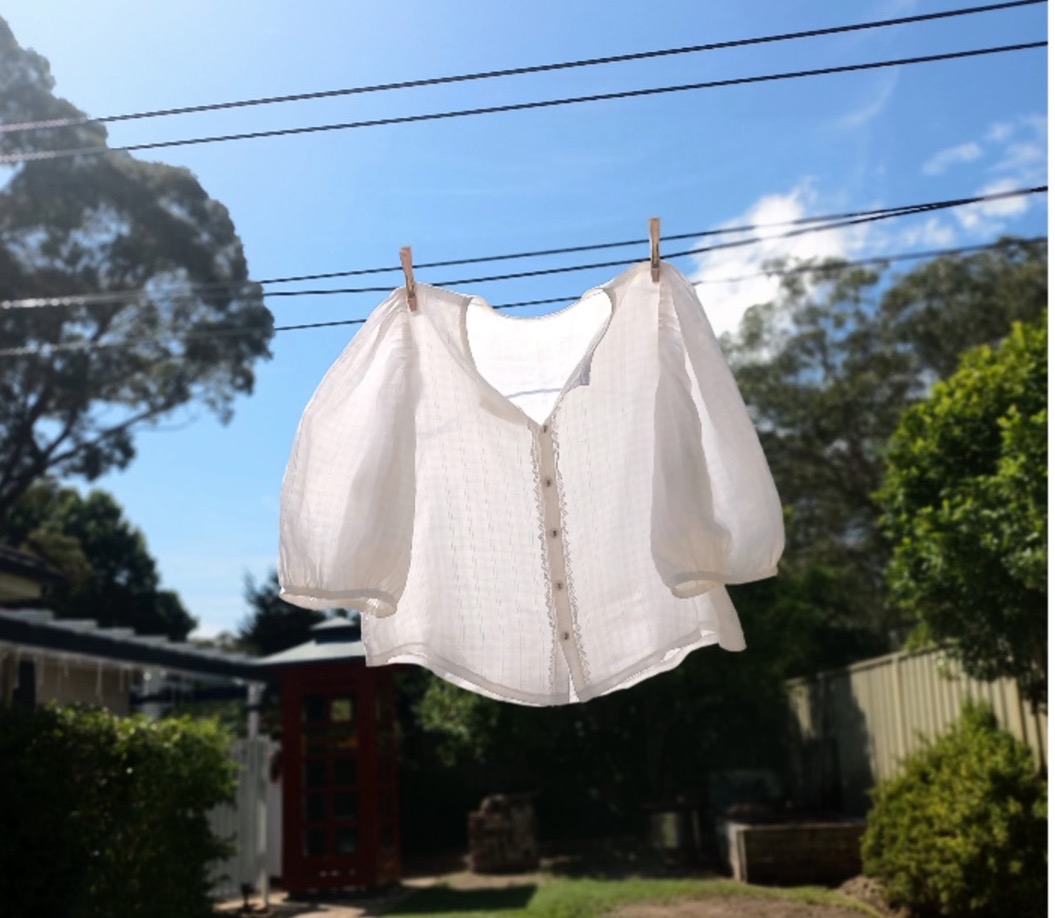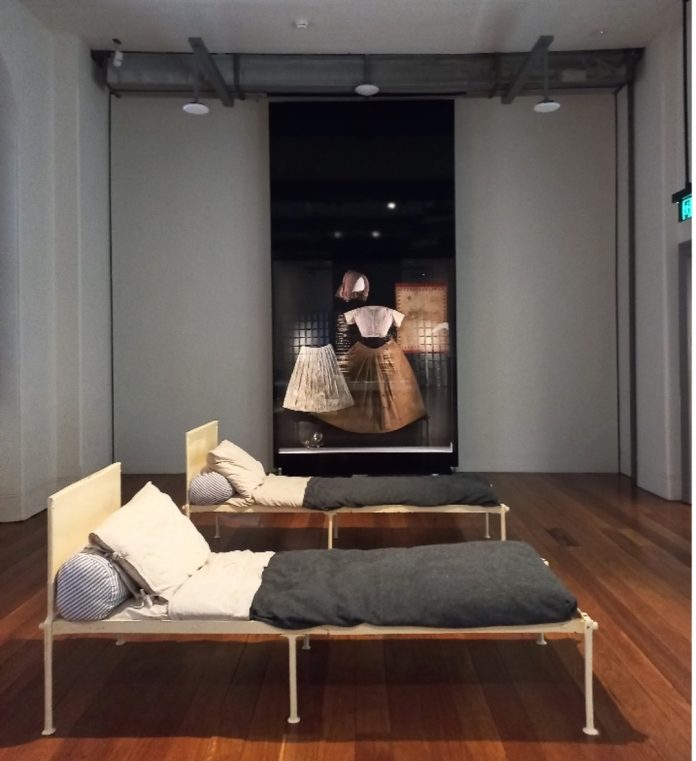On arrival at Sydney’s Hyde Park Barracks, I immediately climb the institution’s squeaky timber staircase to the third floor. Disappointed and then a little baffled, I head back down through the second floor’s similarly narrow hallways to the ground floor, where, in two dark, mood-lit rooms, I finally found them.
In 1980, the then-judicial building was selected for conversion. Its new purpose was to be a museum to exhibit its own history as one of Sydney’s earliest, and in many ways monumental, institutional buildings.
Penny Crook and Tim Murray reveal in their Archaeology of Institutional Refuge that deposited underneath the floors of levels two and three, archaeologists had uncovered a significant palimpsest deposit of lost or hidden artefacts. This included a truly rare archaeological find: textiles.
In the north-east room of the ground floor, two single metal frame beds obstructed my path―a noticeable contrast from the museum display of cramped convict hammocks on the third floor. There, from 1862 until 1886, 200-plus women aged between 18 and 94 had lived in the Government Asylum for Infirm and Destitute Women while unable to support themselves.
Below them, on level two, thousands more young, orphaned, and pauper women had passed through the Immigration Depot with their shared domestic toolkits guiding them into their new socio-economic realities.
The curated selection of sewing material I sought features the physical traces of the Level Three residents’ domestic responsibilities. These, Matron Lucy H Hicks revealed in an 1873 report to the Public Charities Commission, included the making and repairing of all the Asylum’s linen and clothing.
Distinguished in a tall glass cabinet on the far wall of the long, narrow dormitory-style room, a soft cloth bonnet, heavily deteriorated skirt, well-used and mended apron, and a single shoe, were styled together with one particular bodice which archaeologist Peter Davies describes as being of “very individual manufacture”.
Undyed calico sleeves adorned the purple printed cotton body so lightly coloured it resembled those well-washed bed sheets you love for their softness but mourn a little for their fragility. I couldn’t touch to confirm.
My own favourite textile haven is not far from the Barracks in Sydney’s old ‘rag trade’ district, Surry Hills. Hidden away among the terrace houses and brick factory buildings, a couple of the remaining textile retailers are Aladdin’s caves, mishmashes of deadstock fabrics sourced from the waste that manufacturers and brands create by over-ordering or over-producing fabric, and is otherwise destined for incineration or decoration for landfill.
Sadly, the United Nations (UN) advises that the fashion industry produces “more than 8% of the [planet’s] greenhouse gases and 20% of global wastewater annually”, with 85% of textiles then burned or discarded. The stores attract home ‘sewists’ like me who seek a form of creative sustainability: reclaimed quality waste at an accessible price.
In the Barracks’ temperature-controlled exhibit is a curated selection of the sister textiles to the bodices’ purple floral print: beautiful foliate and geometric designs in various shades of mauve. Tracing their origins, Davies further reveals that their abundance reflects the increasing accessibility of the imported printed cottons for institutions like the Asylum, as the recently acquired synthetic colour went out of vogue.
Not included in the display but documented elsewhere by archaeologists are the many more numerous ways the textiles and embellishments were chosen and combined, cut or torn from former garments to be upcycled and reused, and individually hand-stitched.
Nonetheless, standing before the bodices display cabinet, my mind’s hands re-traced the familiar patterns and gestures I recognised in the stitched hems, secured fasteners, and mended tears. As an archaeology student, I now know to seek these traces of individual action, for they express an agency where words cannot or where authors may not care to.
As a sewist, I began to wonder how their hopes and aspirations shaped their practice and how their practice helped shape their frustration and pain.

At home, my own clothesline is adorned with a selection of carefully pre-washed fabric purchases. I sit beneath my mandarin tree, only recently picked clean by the local sulphur-crested cockatoos, to enjoy a windy Australian spring interlude and the textile ensemble’s whipping scherzo of colour and sound.
One fabric, a crisp linen and cotton blend with a check pattern woven throughout, draws my attention. Semi-opaque, it softly captures the sunlight in a way that filmmakers of historical dramas favour. I have visions of a young P L Travers, at the turn of the twentieth century, running through drying laundry as imagined in the 2013 film Saving Mr Banks. In my imagination, a shape begins to form, and I quietly congratulate myself for initiating the mischief of choosing my own adventure.
The sunroom where I work is typically warm and light-filled, although, on rainy days, I enjoy a pit pat melody on the tin roof. Once the wild winds settle, a warm stillness accentuates the liveliness of my thoughts as I scrutinise the sequence of steps I require to cut, assemble, and fit the button-up blouse that I envision.
Well acquainted with my own non-standard proportions―a reliable source of retail shopping disappointment―I have already adjusted the pattern’s proportions to suit. But as ever, it is an open-ended game plan because as the two oversized, gathered sleeves take shape, I am already anticipating the possibilities and practicalities of recovery in the event of a failed attempt (cue abundant frustration), but also future upcycle or recycle opportunities―the sewist’s prerogative.
Indeed, the UN further reveals that as industrial clothing production has “doubled” in the last 15 years, at the same time, “the number of times a garment is worn before being discarded has decreased by 36%”.
A selection of vintage linen-covered ‘laundry’ buttons and a repurposed fine lace trim should complete my vision. I enjoy fastening buttons with a needle and thread and have recently been struck by the endurance of both the tool and the gesture.
Archaeologist Ian Gilligan, who studies the origins and role of clothing and textiles, notes that bone-eyed needles provide indirect yet tangible traces of a clothing practice at least 30,000 years old, while punctured artefacts which suggest leather working activities may stretch the archaeological record to 40,000 years.
Historian Lorinda Cramer illustrates that as recently as two centuries ago, sewing was a skill necessary for all immigrants to the Australian colonies. This was for making and repairing belongings, earning an income in domestic roles or at institutions, or shaping individual or family identity in a ‘new’ and yet familiar world.
In and out, my steel needle easily directs a length of white thread through fabric and button, always securing it one more time than strictly necessary. Often, when people learn that you can sew, they raise their own inability to “even sew on a button”.
In a “Care-full Re-membering”, Australian academic and textile artist Sera Waters equates the loss in today’s world of these homemaking “habits, rhythms and skills” to a loss of a certain kind of social memory: “a collective cultural forgetting” of the traditions and knowledges accumulated through generations of sewists, particularly of women, and which shape and give recognition to “untold truths”.
I have not been able to leave the Barracks and my research without feeling that something in my practice has been regained and there is something more to be reclaimed.


